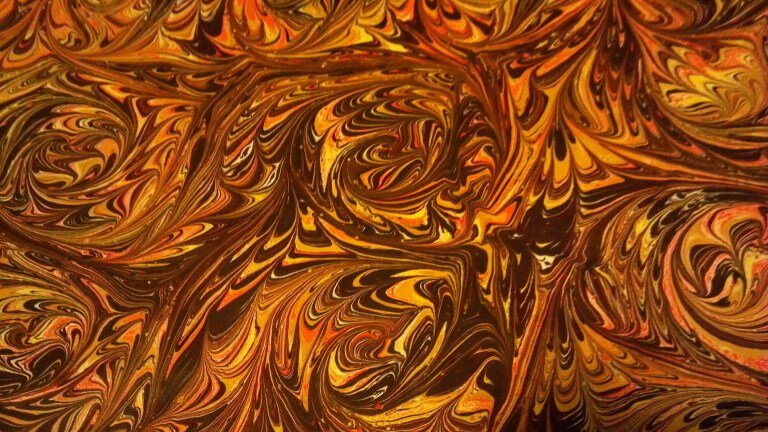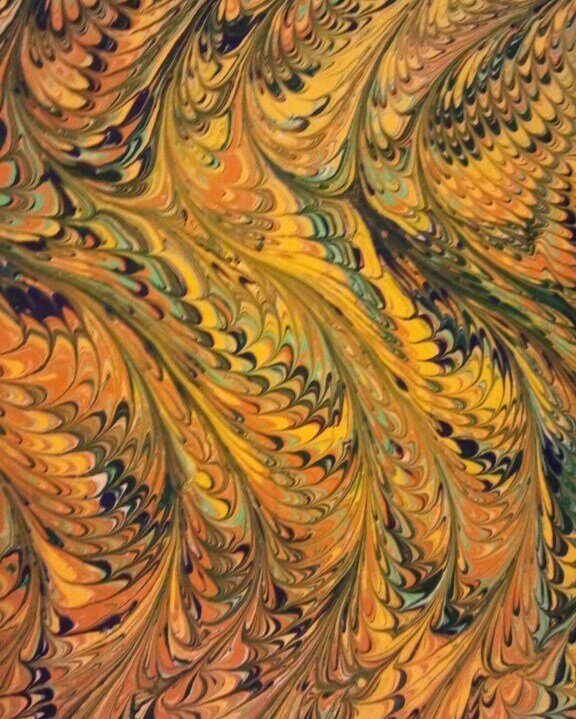Painting on Water: The Art of Paper Marbling
What characteristics do you associate with an old book? A leather binding? Maybe gilt edges? How about marbled paper?
While examples of marbled paper are extremely common, particularly in books from the 18th and 19th centuries, the actual craft was a closely guarded secret of specialized guilds for hundreds of years. Bookbinding guilds were forever attempting to infiltrate marbling guilds to learn the secret of creating marbled paper, à la Charlie and the Chocolate Factory…
Origin
As with many important inventions from antiquity, paper marbling first began in China. The earliest examples of marbled paper actually survive from the suminagashi process brought to its aesthetic peak in Japan. But, as with paper itself, the art of marbling paper arrived in Europe via the Middle East.
Dates
It’s tough to nail down exact dates for the birth of paper marbling: the earliest specimens don’t survive, so scholars have to rely on written references to the art in books. It’s generally argued that the Turks developed a system of marbling (separate from the Chinese/Japanese style) in the 12th century or so, though certainly by the 15th century. Marbled paper didn’t make its appearance in Europe until the 16th century.
Above: this design, created by manipulation with tools after the paint has been applied, is fittingly called Peacock. (I made this!)
Purpose
Marbled paper can be incredibly beautiful, and certainly that’s a purpose in itself. However, it was also used for a very specific purpose, possible because of the unique nature of the marbling process.
Marblers are the Heraclituses of book arts: they say that it is impossible to make the same piece of marbling twice. You see, to make this paper, each piece of paper is pressed into a solution of paint that floats above the surface of a thickened water solution. After a single pressing, the paint will adhere to the (properly primed) paper. A new pressing requires a new application of paint. No matter how one tries (and marblers do try!), the creation of an exact copy by hand is impossible.
Above: My favorite piece of marbling that I will never, ever replicate.
Marbled paper was used for official documents, or essentially any document at risk for forgery. Because each page was unique, a forgery made to be an exact copy of the original would be impossible. In fact, Benjamin Franklin took advantage of this in the 1770’s by designing a Continental currency with marbled patterns on the reverse specifically to prevent counterfeiting.
Soon marbled papers were appropriated for books, but most particularly for endpapers. The complex patterns achieved in marbling were ideal to mask the folds, strings, mull linings, and other more or less unsightly behind-the-scenes aspects of a bound book. This is why most marbled papers one sees are the papers that cover the inside boards (covers) of a book and its facing page.
Marbled endpapers on an 1833 edition of Mansfield Park.
Dangers
For many hundreds of years, the process of paper marbling was indeed considered dangerous because of the toxic elements and chemicals used in the various paints required for the process. It didn’t help that the ultra-secret nature of creating marbled paper meant working behind locked doors, likely with little ventilation. Speaking of which…
Secrecy
The marblers’ guilds relied on keeping the art of marbling secret in order to retain a monopoly on creation. Naturally this made marbled papers rather expensive, resulting in a constant tension between bookbinders (who needed the marbled paper for their endpapers) and the marblers themselves. To keep the secret, marblers would often work at night and behind closed doors—even within their own laboratory, so that apprentices could not learn every step of marbling before they had proved themselves by, oh, a few decades in the guild. In other words, unless one was born into a marbling family, it was very unlikely one would ever even learn the complete process of marbling. Even then, apprentice marblers might not learn the whole process until their late 30s or 40s.
How to make marbled paper
Now let’s celebrate the fact that anyone today can make marbled paper, thanks to a few brave souls in the 19th century who published works revealing the secrets. The basic principles are startlingly simple:
Make a water bath solution with some type of thickening agent (carrageenan is generally used today). This will cause the paint to lay on the surface when applied.
Prime your paper with a solution (usually an alum solution) so that the paint will stick to it.
Splatter your paint onto the water bath solution, working in layers of color. (This is the most complex part, as there are many ways to accomplish this and to manipulate the paint on the surface with tools, as well.)
Place your paper gently onto the bath solution, smooth out the bubbles, pull the paper up, and let dry.
A special shoutout is required here: I learned a good deal of this at a Paper Marbling seminar over at the UNLV Special Collections with Michael Frazier, where I made some of the examples shown above. Check for similar tutorials in your area.
Like any art, there is a lot of nuance to great marbling, from the mix of colors, to the manipulation of those colors, even to the humidity of the environment and how it affects the paints. Not only is it fun to experiment and rewarding to create such beauty, but it’s exciting to think that you can practice an art that was kept secret at all costs for hundreds of years. Now go, bibliophiles, and create.
First published 7 February 2013.




